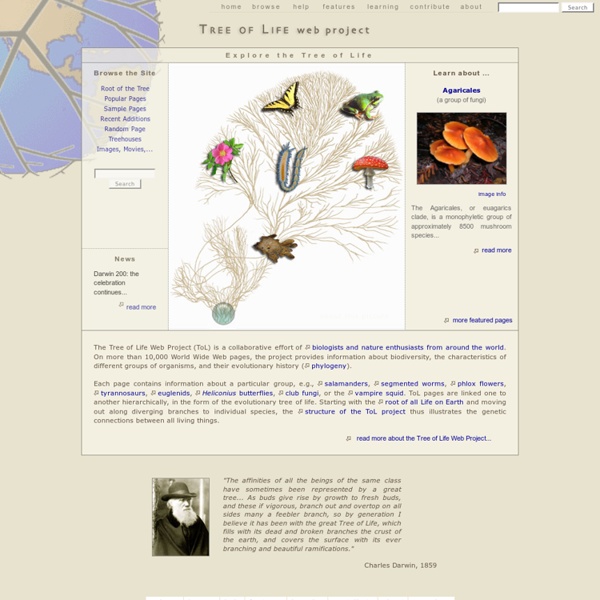



Phylogeny/Island Biogeography PREFACE ISLAND BIOGEOGRAPHY and Evolution is an activity about the evolution of three species of lizards on the Canary Islands. It is designed for high school biology students. Its purpose is to demonstrate to students that evolutionary problems are complex, and solutions may involve data from various disciplines of science. First, students must arrive at different phylogenetic solutions using only geographical and geological data. Then, students compare the morphology of the species involved, arriving at a more traditional solution to phylogeny.
one painter > Matthew Cusick Потрясающие коллажи из карт создает талантливый художник из Техаса Matthew Cusick. Это настоящая живопись без холста и красок. / Talented Texas-based artist Matthew Cusick makes staggering collages from the maps. These are real paintings but without any canvas and painting.Matthew Cusick The Loom Your hands are, roughly speaking, 360 million years old. Before then, they were fins, which your fishy ancestors used to swim through oceans and rivers. Once those fins sprouted digits, they could propel your salamander-like ancestors across dry land. Fast forward 300 million years, and your hands had become fine-tuned for manipulations: your lemur-like ancestors used them to grab leaves and open up fruits. Within the past few million years, your hominin ancestors had fairly human hands, which they used to fashion tools for digging up tubers, butchering carcasses, and laying the groundwork for our global dominance today.
NSF-EID Lyme disease gradient project NSF Emerging Infectious Disease Award EF-0914476 Lyme disease (LD) is the most common vector-borne disease of humans in the U.S., with most cases acquired from the bite of nymphal blacklegged ticks (= ‘deer ticks’). These ticks are found throughout the eastern U.S. (see map), yet 93% of LD cases occur in ten Northeast, Mid-Atlantic and Upper Midwest states. Life Science Learning Goals Which skull is a lizard and which is a snake? During this session, you will have an opportunity to build understandings to help you: Human Evolution: The fossil evidence in 3D Welcome to the UCSB online 3D gallery of modern primate relatives and fossil ancestors of humans. This gallery contains five modern primate crania, and five fossil crania. The crania can be rotated 360 degrees. Each cranium is accompanied by a short description of its relevance to human evolution, and a site map. You will need the Shockwave plugin from Macromedia to view this gallery (most browsers have this installed already). If necessary, you can obtain this plugin here.
Baby’s First Butcher Shop, Circa 1900 PETA would never approve: This grisly 1840 doll-sized butcher shop with miniature animal carcasses and a floor covered in sawdust and blood would be shockingly graphic to our modern sensibilities. After all, here in the 21st century, we like to remain cheerfully oblivious about where our meat products come from. But in Victorian times, such detailed model butcher shops were not uncommon, says Sarah Louise Wood, a curator at the Museum of Childhood at the Victoria and Albert Museum in London.
AP Biology Investigative Labs Supplement to the first printing: This Supplement to the First Printing of the lab manual includes updated URLs, corrections, clarifications, sample data tables for Investigation 7, and an updated version of the AP Biology Equations and Formulas appendix. The second printing of the Teacher Manual, available for download below, incorporates these changes. Recombinant DNA Construction of recombinant DNA, in which a foreign DNA fragment is inserted into a plasmid vector. In this example, the gene indicated by the white color is inactivated upon insertion of the foreign DNA fragment. Recombinant DNA (rDNA) molecules are DNA molecules formed by laboratory methods of genetic recombination (such as molecular cloning) to bring together genetic material from multiple sources, creating sequences that would not otherwise be found in biological organisms. Recombinant DNA is possible because DNA molecules from all organisms share the same chemical structure. They differ only in the nucleotide sequence within that identical overall structure.
Life Science Learning Goals Natural variation During this session, you will have an opportunity to build understandings to help you: Recognize how populations vary with regard to inherited traits Distinguish between DNA, chromosomes, and genes Relate genes to variation in populations Describe the process of adaptation through natural selection Video Overview How is it that life always seems to find a way?
Artificial Selection in Evolution - Free High School Video What Is Artificial Selection? You've likely heard of natural selection, which is often described as the 'survival of the fittest.' This is a bit of a misnomer, because in evolution, individual organisms don't willfully adapt to their environment. Rather, environmental stressors lead to the selection of specific traits among individuals within a population, pushing those traits forward through time. Oatmeal Cookie Product Reviews / Main Nibbles / Cookies, Cakes & Pastry All types of cookies: on this page, cookies beginning with the letters N, O, P & Q, including oatmeal cookie, Pfeffernüsse and pressed cookie. See our many other informative food glossaries—especially the Cake Glossary and Pastry Glossary. There are thousands of different cookies in the world; this glossary’s objective is to highlight those found in the U.S.
MOLO - Proteins: From Sequence to Structure Overview By working their way through a series of models of polymers of increasing complexity, students can recognize forces responsible for protein's 3D shape. They compare folding of the same chain of amino acids in water and lipids, experiment with different sequences of amino acids and learn how charges, polar and non-polar amino acids affect the shape of a protein. Then students apply this knowledge to the case of Sickle Cell Anemia, in which a single point mutation causes the replacement of charged amino acid to a non-polar one, resulting in a misshaped protein.